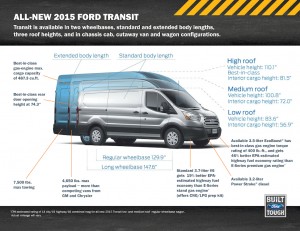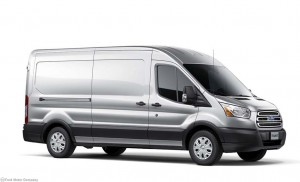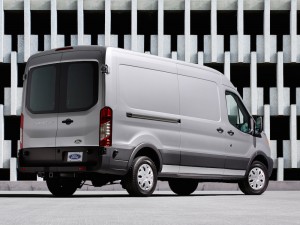
The 2015 Ford Transit can be configured 58 different ways, including two wheelbases, to allow it to meet the needs of the commercial vehicle market.
Over the years, the Ford Motor Co. has outflanked its rivals by quietly conquering the world of work.
In the U.S., roughly 41% of the vehicles used for commercial purposes. It’s a broad category that includes airport shuttle vans as well as vehicles used by government agencies, mining companies, energy companies, and at construction sites and on farms, are now built by Ford. In addition, 20% of all vehicles sold around the world are used commercially so staying on top is a strategic priority for the company.
So Ford has invested $1.3 billion dollars in the development of a replacement for the big commercial E- Series van, which, with few changes, has been a mainstay of the Ford fleet for a half-century, and the best-selling commercial van used by plumbers, contractors and companies that offer delivery service of various kinds.
The new Transit van, which drew on the experience and resources of the entire Ford enterprise through the “One Ford” plan, gives what Ford thinks is the best vehicle in the segment. Having a vehicle like this is critical to the company, noted Minyang Jiang, the brand manager for the Transit, which will have to compete with vehicles such as the Mercedes-Benz Spring, Fiat Chrysler Automobiles ProMaster and Nissan’s new NV2500 and the Chevrolet Express.

Ford's 2015 Transit van is replacing the old E-Series full-size van and will be offered with the maker's new Power Stroke I-5 diesel.
Minyang, however, said, “One Ford” has endowed the new Transit with new power trains, including an EcoBoost and diesel options, a new chassis and new stability controls as well as no fewer than 58 different body styles. The van comes in three different heights, three different lengths and two different wheelbases.
The Transit also will be available with driver assistance, telematics and vehicle tracking systems as well as a large curtain-style airbags to protect riders in a Transit outfitted to carry passengers either to and from airport terminals or to carry sports teams to away games. The new van offers a huge improvement in safety for passengers in vehicles such as airport shuttles, Minyang said.
In addition, the cab of the Transit is relatively quiet, easing the stress on drivers or passengers.
Even on a short drive the Transit impressive. It handled well even in tight corners and the steering the was smooth and efficient and even the 3.2-liter, third generation in-line five cylinder diesel engine Ford is using in the Transit is quieter than a comparable diesel found in the Mercedes-Benz Sprinter.
Head toss is minimal since the chassis is equipped with a stability control system that constantly monitors the vehicle on the road and manages the vehicle’s roll on curves, through turns and on all kinds of road surfaces.
The cabin area has been upgraded to the controls are easy for the driver to reach.

Ford is looking for the new configurable Transit to take up the slack for the discontinued E-Series van.
The 3.5-liter V6 EcoBoost engine is the same engine that has proven successful in the F-150, Minyang said.
(Honda adds another 1 million vehicles to recall. For more, Click Here.)
The standard 3.7-liter V6 is also more efficient and overall Ford estimates the new powertrain will reduce fuel consumption by a whopping 46%, saving typical owners almost $1,700 per year, Minyang said. Transit vans equipped with diesel engines, which are built at a Ford plant in South Africa, which yield even better fuel economy, are expected to represent about 20% of mix.
(Click Here for details on Volvo’s bold claims about the new XC90 SUV.)
The variety of body styles means that Ford can tailor the van to suit the needs of a wider array of users. In addition, Ford invited outfitters to participate in the program and nearly a dozen of already set up operations around the Ford plant in Kansas City, Missouri, where Ford has been invested more than $1 billion in a Transit assembly line. The first new Transits rolled off the assembly line in April.
(To see why Tesla is trying to recover a recently wrecked Model S, Click Here.)
By locating near the plant, the outfitters will be able to use the 350 specially built railcars Ford had built to ship the new vans across North America, according of Ford spokeswoman Jessica Enoch.
Ford was selling about 100,000 E-Series vans annually when the company finally took them out of production. Ford, however, hopes the Transit – with its variants – will outsell the E-Series. The Transit is also a global vehicle and will be built not only in Europe, but also in China, Minyang said.
